
Adi Talwar
Marlene LaSalle showing the scar from the deep cut she received on her forearm while trying to break a window to get out of her house during Superstorm Sandy.
City Limits is participating along with hundreds of news organizations around the world on climate-related stories in the week leading up to the United Nations Climate Summit. More at #CoveringClimateNow.
Seven years after Hurricane Sandy made landfall, when Marlene LaSalle describes what happened to her Staten Island home on the night of October 29, 2012, she still gets emotional.
“This is the scar that reminds me of all of this,” she tells City Limits while pointing to a long winding cut on her right arm that marks the area where she had to get surgery to repair muscles, tendons, ligaments, and nerves in 2012.
“I used to be a righty. And I had to teach myself to redo everything with my left arm. But the fear of losing everything comes back when I think about Sandy. That night was so eerie. I thought the world was ending. And I can still remember the pungent smell of seawater everywhere.”
The eastern shore of Staten Island was flooded with a 20-foot storm surge that slammed into homes and swallowed up entire streets. Twenty-four Staten Islanders died during the storm—some of them trapped, drowned in their own houses.
When survivors today tell their stories about Sandy, they often underline the courage and grit that Staten Islanders needed to get back on their feet. Scientists studying global warming tell another story. They say that the best odds for surviving future hurricanes and rising sea levels is to retreat.
The experiences of residents in Staten Island’s most vulnerable neighborhoods, however, illustrate the difficulties—especially for people with low or moderate incomes—involved in staying put or taking flight, and the lack of comprehensive government policies to address those challenges.
The price of escape
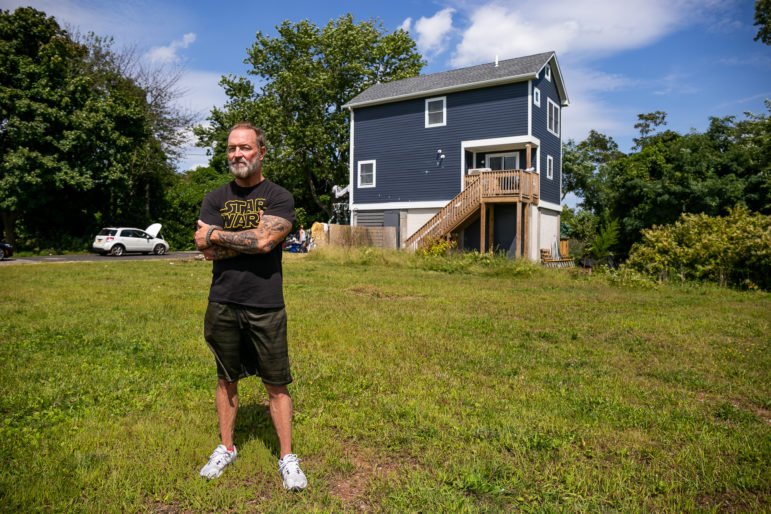
Adi Talwar
John Collins near his elevated home on Quincy Avenue in the Midland Beach neighborhood of Staten Island. Collin’s house is the only one to have been restored at his end of the city block.
A recent paper by the journal Science calls for “strategic and managed” retreats that would relocate entire communities in flood-prone areas to safer ground.
Scientists point out that relocations are often done in ad hoc ways that prioritize risk reduction over broader community needs. And these resettlements can ultimately raise inequality—wealthy homeowners could afford to take a financial loss and relocate, but lower-income residents might get stuck or left behind in homes with high-risk flooding.
John Collins, a resident in Midland Beach, who had his home elevated 14 and half feet after the storm, found that retreat was unaffordable.
“At the beginning, my biggest concern was being safe,” Collins said. “But we couldn’t afford to relocate. No matter what the deal was I would still owe money. And I wouldn’t be able to afford to live in New York City today if I had not bought my house 18 years ago.”
Like other homes in Midland Beach, Collins’ house was originally a summer bungalow. Through the years, it was converted into a full-time home with insulation and an extension. But while Collins thought that his home was safe and durable, the storm surge ended up shifting the house and almost swallowing it whole.
“Neighbors told me you could only see the dish on the top of my roof,” he said. “When we came back later, the water had already receded, but we found ourselves suddenly homeless. And without an affordable plan to relocate, I had to tap into my savings and 401k to rebuild.”
Pending a revision of New York City’s flood maps, 400,000 residents currently live on a 100-year floodplain. And just like Collins, this means that they have a 1 percent chance (or greater) of flooding in any given year.
In some cases, the state is already buying homes in high-risk flood areas with the intent to demolish them and later protect the site as a natural flood barrier for surrounding communities. Since Hurricane Sandy, New York State has bought 650 properties for $254 million.
But experts say that this is not enough to address the long-term reality of an environment that is changing fast.
After the waves, inequality reshaped neighborhoods
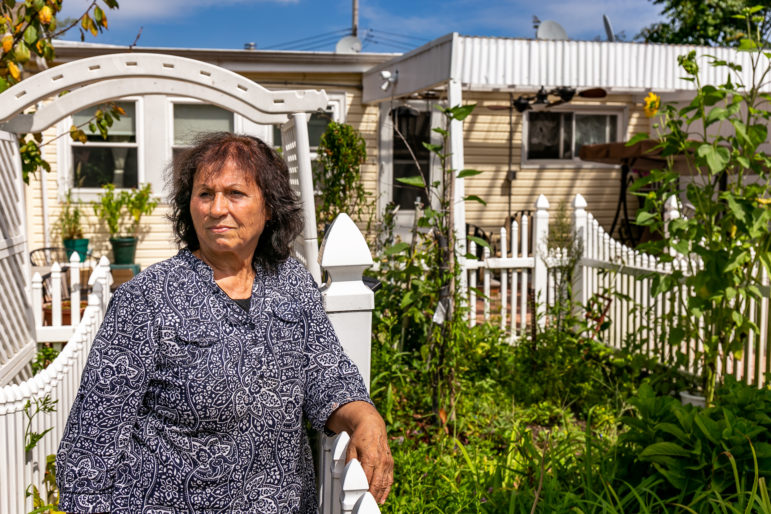
Adi Talwar
Fathia Abdel Kader in the backyard of her Cherokee Street house in the Midland Beach neighborhood of Staten Island. Fathia moved to Cherokee street in the early 1970s. Fathia and her husband choose not to elevate their home due to concerns of negotiating steps at their age.
Just a few blocks away from Collins’ home, Farid Kader—the co-founder of the Staten Island disaster relief foundation Yellow Boots, and a nephew of Marlene LaSalle—points out different types of properties that had to be torn down and later rebuilt after Sandy.
“There were homes in Midland Beach that were completely annihilated,” Kader said. “We had to gut them out until there was nothing left. And even in some cases the studs were bad. So we had to knock them down too.”
Kader explained that many properties in the flood zone with existing mortgages were required to elevate their homes in order to satisfy both insurance and hurricane assistance requirements.
But other homeowners who did not have mortgages, did not qualify for assistance, or simply couldn’t afford to relocate, opted to rebuild without elevating.
“Some homes that were rebuilt after Sandy look like standalone houses in the middle of Central Park,” Kader said. “Because of the ways they were rebuilt, and the types of buyouts, some homes are now surrounded by empty lots.”
Homeowners who could afford to take the buyout relocated. And Kader pointed out that those who couldn’t do so often owed more money for their homes than the current market value.
For other Staten Island residents, deciding between rebuilding and relocating was also emotionally tough.
“My husband has dementia,” says Sophia Stonick, a resident on the southern border of New Dorp. “This is his home. It’s one of the last familiar places he knows. And he would be lost anywhere else.”
LaSalle’s husband also has a lifelong attachment to his home.
“You can put sandbags as high as you want, but when so much water comes, you have no control,” says Nader Tallat. “She [Marlene] wants to move since the hurricane. Even now. But these are my roots. My Mom died in this house. And this is where I want to die.”
And while LaSalle now stores more things on the second floor of her house to protect them from flooding, she can’t avoid thinking that the ocean might someday reclaim their home.
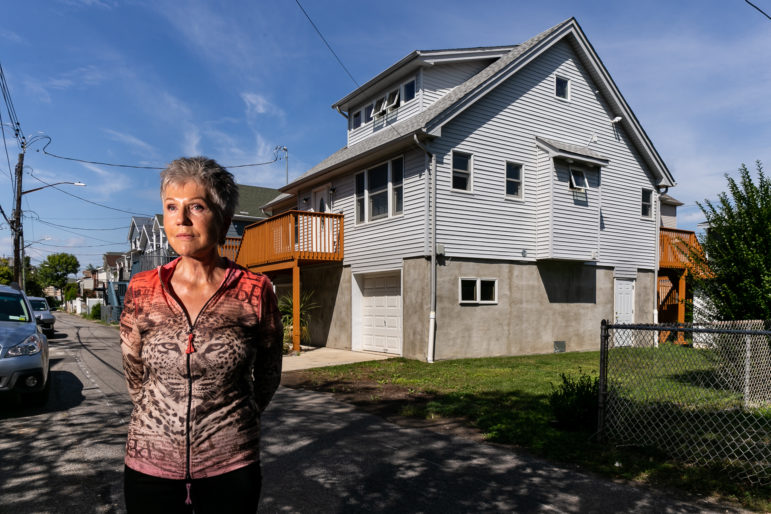
Adi Talwar
Sophia Stonick a Neutral Avenue resident in the New Dorp neighborhood of Staten Island. Sophia’s elevated house can been seen in the the background.
Chased by waves
Around 8 p.m. on October 29, 2012, while people by the shore were already desperately climbing onto their rooftops and holding onto anything that could save them from drowning, LaSalle’s family—which lives roughly one mile inland in Midland Beach—could not imagine all the water that was coming their way.
“The damage was biblical,” she says. “Water reached the top of the gazebo [approximately 10 feet high] and I could see whirlpools of people’s things in my backyard. Then the backdoor burst open with the pressure of the water. The lights flickered on and off, and you could hear sparks, until everything went completely dark.”
LaSalle had five children then—ages six to sixteen—and she immediately herded them up to the second floor. Fearing that the electric sparks could make the house go up in flames, she smashed the double pane glass of a crank window in the front and pushed her kids out to the street where it was more elevated.
“As soon as I pulled my arm away from the glass I saw that it was cut open, to the point where I could see the flesh flapping back and forth,” she says. “We got to the car, but we couldn’t drive anywhere. We were surrounded by water. And luckily, neighbors a few houses down helped me put on a tourniquet.”
LaSalle’s family and other people would later seek refuge at the top of a tall abandoned building. But when the winds picked up they feared that the structure would not hold. So everyone made a run for the public school across the street. Men carrying tools broke into the school, and everyone held out there until they were eventually escorted in National Guard trucks to safety.
“I feel pretty lucky. I got stuck at the school with a nurse and a doctor,” she says. “They washed out my wound and wrapped it. But I remember thinking ‘where do we go from here?’
Advocates need back-up
Almost seven years after Hurricane Sandy, community organizers in Staten Island find themselves caught in between those who want to rebuild in place and those who want to work with the government to develop more comprehensive relocation plans for high-risk flood communities.
“It’s not feasible to continue rebuilding in locations we know will continue to be devastated by natural disasters,” says Rev. Karen Jackson, the leader of a clergy coalition that helped coordinate relief for Sandy-impacted communities. “The most logical and fiscally responsible course of action is to help people relocate.”
Jackson explains that high-income communities are more prepared than low-income residents or communities of color when it comes to advocating for fair buyout programs. And while it will be a challenge to convince entire neighborhoods to accept collective buyouts, she says that organizers can work with elected officials and government partners to educate people about the benefits and necessity of relocation, while being sensitive to the reasons why people may choose to stay.
“These events are going to become more and more frequent because of the reality of climate change,” Jackson says. “The role of community groups is often overlooked. And we desperately need funding for community-based coalitions that will help build long-term recovery strategies and create more spaces for people to mobilize.”
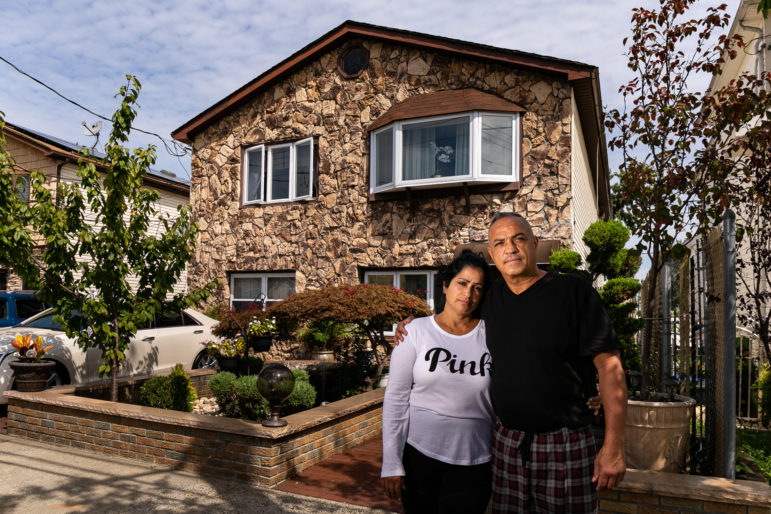
Adi Talwar
Marlene LaSalle and husband Nader Tallat in front of their Bedford Avenue home in the Midland Beach neighborhood of Staten Island.


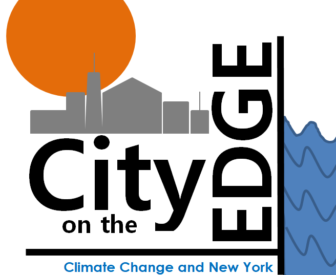







2 thoughts on “Income Inequality is Making it Harder to Escape Storm Risk on Staten Island”
What b——t article. Where is the scientific study proving income inequality was an issue here?
Read the article, Mr. James. If you’re a low-income homeowner it’s harder to afford retrofits. If you’re a homeowner who’s underwater the buyout programs might not have worked for you.